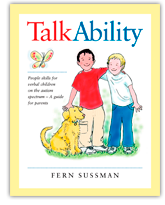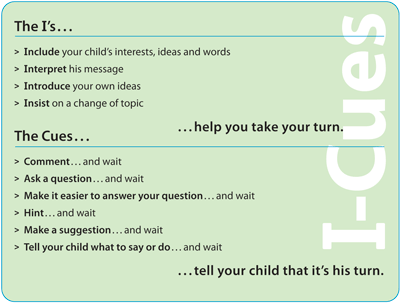TalkAbility™ Resources to Support Speech-language Pathology Services
 An important part of your work with children who have communication challenges is involving their parents in the intervention process so that they can make use of daily routines and play time to develop their children’s communication skills. Including parents in the intervention is no less important for autistic children who speak in sentences. Because these children often speak well, part of your role is to help their parents understand what’s missing in their child’s communication, and what they can do to help him become a better communicator in social situations.
An important part of your work with children who have communication challenges is involving their parents in the intervention process so that they can make use of daily routines and play time to develop their children’s communication skills. Including parents in the intervention is no less important for autistic children who speak in sentences. Because these children often speak well, part of your role is to help their parents understand what’s missing in their child’s communication, and what they can do to help him become a better communicator in social situations.
Parents need accessible, relevant, and practical resources that explain difficult concepts in simple ways and provide concrete strategies for how they can help their child improve his social communication skills.
The Hanen Centre offers effective, parent-friendly tools that can be shared with parents to make it easy for them to continue the learning process at home.
TalkAbility™ — A practical, research-based solution
TalkAbility™ resources were specifically created for parents of young autistic children who are speaking in sentences and having conversations. The guidebook provides parents with the practical knowledge and tools they need to:
- Help their child develop theory of mind skills
- Encourage their child to pay attention to the social messages people send non-verbally
- Help their child have extended, back-and-forth conversations
- Talk so their child can tune in to what others are thinking
- Help their child tell stories and play imaginatively
- Help their child make friends
TalkAbility’s naturalistic approach empowers parents make the most of the everyday activities they do with their child to improve his social communication skills. Practical strategies are explained in simple language that parents will understand, and each strategy is accompanied by beautifully illustrated real-life examples that make the book easy to understand, no matter what the parents’ reading level is.
The guidebook first helps parents zero in on their child’s particular needs, and then demonstrates how to use each strategy with those needs in mind.
Here’s an example of a powerful set of strategies from TalkAbility that help parents build their child’s conversational skills by following their lead, waiting for them to respond, and cueing them to take their turn:
Use your “I-Cues” to Keep the Conversation Going

The strategies outlined in the TalkAbility guidebook are the same ones parents learn in the TalkAbility — The Hanen Program® for Parents of Autistic Children Who Are Speaking in Sentences and Having Conversations. Drawing from extensive cutting-edge research, the program and the guidebook give parents the most up-to-date information on what works best for helping children with social communication challenges.
Research shows, for example, that children who have conversations with parents about what others think and feel learn to appreciate different points of view. So TalkAbility teaches parents strategies for extending conversations with their child and gives them specific “thinking” words to use in these conversations.
To view a detailed research summary and reference list for TalkAbility, click on the link below:

Why use TalkAbility™ resources in your clinical practice?
Speech-language pathologists who have integrated TalkAbility resources into their clinical practice have found it a very useful tool to enhance the intervention process and involve parents.
The resources are an invaluable part of a speech pathologist’s services because they:
- are practical and user-friendly
- reflect current research and best practice
- supplement and reinforce the strategies you are teaching parents
- provide a step-by-step guide for parents to refer to between sessions
- enable parents to apply the strategies they have learned to a variety of everyday routines and activities with their child.
TalkAbility™:
►Can give parents a head start while waiting for services
TalkAbility resources are a great way to empower parents to begin the intervention process while their child is waiting for therapy services. By the time parents see you, they will already be “ahead of the game” in understanding their child’s communication and helping them learn.
►Can supplement therapy sessions and home programming
For families who have already begun therapy, TalkAbility resources can be an effective supplement for home programming, as well as therapy sessions.
You may recommend appropriate strategies from the guidebook to parents or lend them the book to read up on their child’s particular communication style, strengths and areas of difficulty. In therapy sessions, the guidebook is a great way to help parents understand difficult concepts and visualize the strategies in action. (See the case study below for specific examples of how to integrate TalkAbility resources into your therapy sessions).
►Provides you with concrete strategies for promoting theory of mind in autistic children
Even though having a poor theory of mind is considered one of the core deficits in children and adults with autism, there are very few intervention programs that address this issue. The groundbreaking approach in the TalkAbility guidebook provides parents and speech-language pathologists with practical strategies to build empathy and a deeper understanding of another person’s point of view.
The TalkAbility guidebook can show you simple things to do during therapy sessions with these children to help them tune in to the feelings and thoughts of others. In demonstrating for parents what to say and do, you’ll be making it easy for them to continue the use of these strategies at home.
►Helps target the specific needs of individual children
The TalkAbility guidebook includes checklists to easily determine what particular children require the most help with, and how to implement strategies for their particular needs.
For example, the guidebook breaks conversation down into three parts: Initiate, Continue, and End (referred to as “ICE” throughout the book). Conversation checklists make it easy to determine which of these three areas a child needs to improve the most.
Click on the link below to view Conversation Checklist #1: Initiating the Conversation:

►Gives parents ideas for promoting their child’s friendships
TalkAbility teaches parents specific strategies for promoting friendships. Parents use the Social Play Skill Checklists in the TalkAbility guidebook to find out what level of social play their child is at, and then they choose an appropriate goal for their child. For example, a parent whose child doesn’t seem at all interested in playing with other children would learn to focus first on just encouraging their child to play next to another child.
Using TalkAbility™ resources in your clinical practice
The case study below provides an example of how a professional may use the TalkAbility guidebook and DVD in her clinical practice. Click on the excerpts from the resources to see for yourself!
Most of the children on Casey L.’s caseload are autistic. Many of the children she has worked with have made great gains, and by the time they were four years of age, many sounded a lot like their peers. Although Casey’s clinic was funded to treat children up to the age of 6, Casey discharged these children, recommending that their parents find a social skills group so that their children could get practice interacting with their peers. Casey knew that despite their strong language skills, these children communicated very differently in social situations. Some children talked only about things that interested them, like computer games or fans, never considering whether their listener was interested in the same things. Other children insisted on playing games a certain way and would become very upset when someone wanted to play a different way. Casey knew that these children were displaying behavior typical in children with high-functioning autism, who have difficulty with theory-of-mind or taking another person’s point of view into consideration. She just didn’t know how to help them develop this kind of empathy.
Casey confided in a colleague about the challenges she was facing. This collegue had just purchased the TalkAbility guidebook and said that she thought Casey might find it helpful. Casey borrowed the book from her and read it cover to cover that night. She was especially intrigued by Chapter 5, which broke down theory-of-mind development (referred to as “tuning in” in the guidebook), into developmental stages (click here to view a sample page from chapter 5). Since this was new information for Casey, she was sure that it would be new information for parents as well. Casey decided that the next time she had an autistic child on her caseload who spoke in sentences and was having conversations, she would try out some of the ideas that she found in the book.
One week later, Dylan K, a 4 1/2 year old autistic child, who Casey had been seeing since he was 2 years old, returned to the clinic for a recheck. Dylan’s mother reported that she was thrilled with his progress, but still had concerns because, while he seemed to enjoy talking to adults, he didn’t have any friends in his preschool class. To explain “theory of mind” to Dylan’s mother, Casey opened the TalkAbility guidebook to page 70 (click here to view this page), and read the common terms used in the book (e.g., “being on the same page", "reading a person’s mind", and “standing in someone else’s shoes”) Then she showed her the pictures to demonstrate how important tuning-in skills are in making friends. Casey said that she would lend Mom her newly-purchased TalkAbility guidebook so she could read Chapter 5 at home and start to think about what stage of tuning-in Dylan needed to work on.
Since Mom had expressed a concern about Dylan’s lack of friends, Casey opened the book to Chapter 10, page 159 (click here to view this page). This chapter outlines the next steps for a child who is exhibiting no or very little social play, such as having the child stay and play near or beside other children before actually playing with them. Casey and Mom talked about asking Dylan’s teacher to set up activities for Dylan, during which he could get comfortable being near, but not with, other children. The pictures in Chapter 10 gave Mom some ideas about not only what the teacher could do, but what she could do when another child came over to the house to play. The guidebook also provided Dylan’s mom with helpful guidelines for choosing a first friend for Dylan.
What Professionals Say About TalkAbility™…
“Incredibly useful and immediately clear, this people-skills handbook provides gentle guidance and thoughtful suggestions… a must-read for all parents, caretakers and teachers of young children, autistic and non-autistic alike, whose potential for all types of communication has not yet been explored, tapped or fully reached.”
— Katherine B. Olson, Spectrum Magazine
"TalkAbility contains a wealth of valuable material for parents and caregivers of young children who may have a diagnosis on the autistic spectrum or simply have social difficulties. Beautifully written, clear and immediately usable, there are few books that parents will find as accessible and full of useful tips as this one.”
— Simon Baron-Cohen, Ph.D.
Director, Autism Research Centre
Professor of Developmental Psychopathology, University of Cambridge
Help parents build the social skills their child needs to have extended conversations with others and make new friends. Order the TalkAbility guidebook today.
